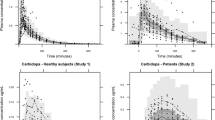Abstract.
We conducted a pharmacokinetic study in 164 patients with sporadic Parkinson's disease (PD) to address the relationship between body weight and levodopa pharmacokinetics. Patients underwent an oral acute levodopa test with 250 mg levodopa and pharmacokinetic variables were further assessed. Plasmatic levodopa area under the curve (AUC-l) and body weight were significantly and inversely correlated. Women were significantly lighter and more dyskinetic than men, and had greater AUC-l values. Our data suggest that during long-term treatment, lighter PD patients, especially women, may receive a greater cumulative dosage of levodopa per kilogram of body weight. This could explain gender differences for the development of levodopa-induced peak-dose dyskinesias observed during the course of the disease.
Similar content being viewed by others
Author information
Authors and Affiliations
Additional information
Correspondence to M. Zappia
Rights and permissions
About this article
Cite this article
Arabia, G., Zappia, M., Bosco, D. et al. Body weight, levodopa pharmacokinetics and dyskinesia in Parkinson's disease. Neurol Sci 23 (Suppl 2), s53–s54 (2002). https://doi.org/10.1007/s100720200066
Issue Date:
DOI: https://doi.org/10.1007/s100720200066




